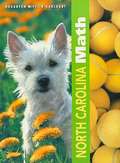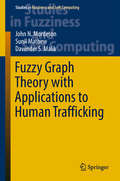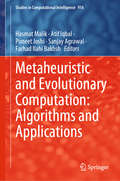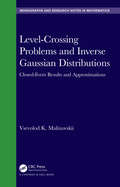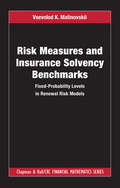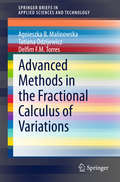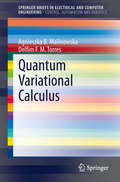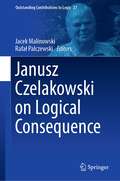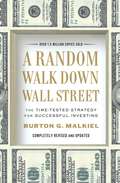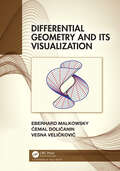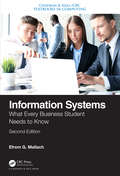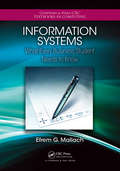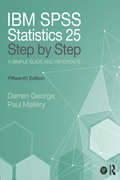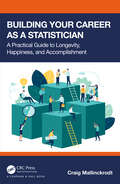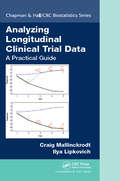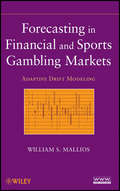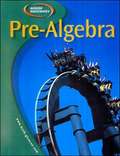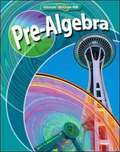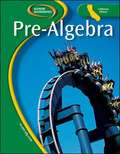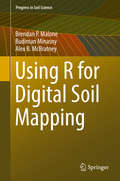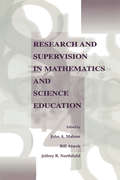- Table View
- List View
HSP Math [Grade 4]
by Evan Maletsky Joyce Mcleod Karen Norwood Tom Roby James Mendoza Epperson Juli Dixon Janet Scheer David Wright David Molina Jennie Bennett Lynda Luckie Angela Andrews Vicki Newman Barbara Montalto Minerva Cordero-EppersonNIMAC-sourced textbook
Fuzzy Graph Theory with Applications to Human Trafficking (Studies in Fuzziness and Soft Computing #365)
by Davender S. Malik Sunil Mathew John N. MordesonThis book reports on advanced concepts in fuzzy graph theory, showing a set of tools that can be successfully applied to understanding and modeling illegal human trafficking. Building on the previous book on fuzzy graph by the same authors, which set the fundamentals for readers to understand this developing field of research, this second book gives a special emphasis to applications of the theory. For this, authors introduce new concepts, such as intuitionistic fuzzy graphs, the concept of independence and domination in fuzzy graphs, as well as directed fuzzy networks, incidence graphs and many more.
Metaheuristic and Evolutionary Computation: Algorithms and Applications (Studies in Computational Intelligence #916)
by Hasmat Malik Atif Iqbal Puneet Joshi Sanjay Agrawal Farhad Ilahi BakhshThis book addresses the principles and applications of metaheuristic approaches in engineering and related fields. The first part covers metaheuristics tools and techniques such as ant colony optimization and Tabu search, and their applications to several classes of optimization problems. In turn, the book’s second part focuses on a wide variety of metaheuristics applications in engineering and/or the applied sciences, e.g. in smart grids and renewable energy. In addition, the simulation codes for the problems discussed are included in an appendix for ready reference.Intended for researchers aspiring to learn and apply metaheuristic techniques, and gathering contributions by prominent experts in the field, the book offers readers an essential introduction to metaheuristics, its theoretical aspects and applications.
Aristotle's Modal Syllogistic
by Marko MalinkAristotle was the founder not only of logic but also of modal logic. In the Prior Analytics he developed a complex system of modal syllogistic which, while influential, has been disputed since antiquity--and is today widely regarded as incoherent. In this meticulously argued new study, Marko Malink presents a major reinterpretation of Aristotle's modal syllogistic. Combining analytic rigor with keen sensitivity to historical context, he makes clear that the modal syllogistic forms a consistent, integrated system of logic, one that is closely related to other areas of Aristotle's philosophy. Aristotle's modal syllogistic differs significantly from modern modal logic. Malink considers the key to understanding the Aristotelian version to be the notion of predication discussed in the Topics--specifically, its theory of predicables (definition, genus, differentia, proprium, and accident) and the ten categories (substance, quantity, quality, and so on). The predicables introduce a distinction between essential and nonessential predication. In contrast, the categories distinguish between substantial and nonsubstantial predication. Malink builds on these insights in developing a semantics for Aristotle's modal propositions, one that verifies the ancient philosopher's claims of the validity and invalidity of modal inferences. Malink recognizes some limitations of this reconstruction, acknowledging that his proof of syllogistic consistency depends on introducing certain complexities that Aristotle could not have predicted. Nonetheless, Aristotle's Modal Syllogistic brims with bold ideas, richly supported by close readings of the Greek texts, and offers a fresh perspective on the origins of modal logic.
Level-Crossing Problems and Inverse Gaussian Distributions: Closed-Form Results and Approximations (Chapman & Hall/CRC Monographs and Research Notes in Mathematics)
by Vsevolod K. MalinovskiiLevel-Crossing Problems and Inverse Gaussian Distributions: Closed-Form Results and Approximations focusses on the inverse Gaussian approximation for the distribution of the first level-crossing time in a shifted compound renewal process framework. This approximation, whose name was coined by the author, is a successful competitor of the normal (or Cramér's), diffusion, and Teugels’ approximations, being a breakthrough in its conditions and accuracy. Since such approximations underlie numerous applications in risk theory, queueing theory, reliability theory, and mathematical theory of dams and inventories, this book is of interest not only to professional mathematicians, but also to physicists, engineers, and economists. People from industry with a theoretical background in level-crossing problems, e.g., from the insurance industry, can also benefit from reading this book. Features: Primarily aimed at researchers and postgraduates, but may be of interest to some professionals working in related fields, such as the insurance industry Suitable for advanced courses in Applied Probability and, as a supplementary reading, for basic courses in Applied Probability
Risk Measures and Insurance Solvency Benchmarks: Fixed-Probability Levels in Renewal Risk Models (Chapman and Hall/CRC Financial Mathematics Series)
by Vsevolod K. MalinovskiiRisk Measures and Insurance Solvency Benchmarks: Fixed-Probability Levels in Renewal Risk Models is written for academics and practitioners who are concerned about potential weaknesses of the Solvency II regulatory system. It is also intended for readers who are interested in pure and applied probability, have a taste for classical and asymptotic analysis, and are motivated to delve into rather intensive calculations. The formal prerequisite for this book is a good background in analysis. The desired prerequisite is some degree of probability training, but someone with knowledge of the classical real-variable theory, including asymptotic methods, will also find this book interesting. For those who find the proofs too complicated, it may be reassuring that most results in this book are formulated in rather elementary terms. This book can also be used as reading material for basic courses in risk measures, insurance mathematics, and applied probability. The material of this book was partly used by the author for his courses in several universities in Moscow, Copenhagen University, and in the University of Montreal. Features Requires only minimal mathematical prerequisites in analysis and probability Suitable for researchers and postgraduate students in related fields Could be used as a supplement to courses in risk measures, insurance mathematics and applied probability.
Advanced Methods in the Fractional Calculus of Variations (SpringerBriefs in Applied Sciences and Technology)
by Agnieszka B. Malinowska Tatiana Odzijewicz Delfim F.M. TorresThis brief presents a general unifying perspective on the fractional calculus. It brings together results of several recent approaches in generalizing the least action principle and the Euler-Lagrange equations to include fractional derivatives. The dependence of Lagrangians on generalized fractional operators as well as on classical derivatives is considered along with still more general problems in which integer-order integrals are replaced by fractional integrals. General theorems are obtained for several types of variational problems for which recent results developed in the literature can be obtained as special cases. In particular, the authors offer necessary optimality conditions of Euler-Lagrange type for the fundamental and isoperimetric problems, transversality conditions, and Noether symmetry theorems. The existence of solutions is demonstrated under Tonelli type conditions. The results are used to prove the existence of eigenvalues and corresponding orthogonal eigenfunctions of fractional Sturm-Liouville problems. Advanced Methods in the Fractional Calculus of Variations is a self-contained text which will be useful for graduate students wishing to learn about fractional-order systems. The detailed explanations will interest researchers with backgrounds in applied mathematics, control and optimization as well as in certain areas of physics and engineering.
Quantum Variational Calculus
by Agnieszka B. Malinowska Delfim F. M. TorresThis Brief puts together two subjects, quantum and variational calculi by considering variational problems involving Hahn quantum operators. The main advantage of its results is that they are able to deal with nondifferentiable (even discontinuous) functions, which are important in applications. Possible applications in economics are discussed. Economists model time as continuous or discrete. Although individual economic decisions are generally made at discrete time intervals, they may well be less than perfectly synchronized in ways discrete models postulate. On the other hand, the usual assumption that economic activity takes place continuously, is nothing else than a convenient abstraction that in many applications is far from reality. The Hahn quantum calculus helps to bridge the gap between the two families of models: continuous and discrete. Quantum Variational Calculus is self-contained and unified in presentation. It provides an opportunity for an introduction to the quantum calculus of variations for experienced researchers but may be used as an advanced textbook by graduate students and even ambitious undergraduates as well. The explanations in the book are detailed to capture the interest of the curious reader, and complete to provide the necessary background material needed to go further into the subject and explore the rich research literature, motivating further research activity in the area.
Janusz Czelakowski on Logical Consequence (Outstanding Contributions to Logic #27)
by Jacek Malinowski Rafał PalczewskiThis book is dedicated to the life and work of logician Janusz Czelakowski on the topic of logical consequence. It consists of three parts – a biography, a survey and research sections. The volume begins with an autobiographic chapter by Janusz Czelakowski followed by a historical chapter written by Jacek Malinowski. The survey section forms the backbone of the volume with each chapter covering one of Janusz Czelakowski’s results. They focus on his results in the area of logical consequence, demonstrate how his results influenced following research, and presents potential future results, problems and applications. This volume is of interest to logicians and mathematicians.
A Random Walk Down Wall Street: The Time-Tested Strategy
by Burton G. MalkielA book meant to provide a comprehensive investment guide for individual investors.
Differential Geometry and Its Visualization
by Eberhard Malkowsky Ćemal Dolićanin Vesna VeličkovićDifferential Geometry and Its Visualization is suitable for graduate level courses in differential geometry, serving both students and teachers. It can also be used as a supplementary reference for research in mathematics and the natural and engineering sciences. Differential geometry is the study of geometric objects and their properties using the methods of mathematical analysis. The classical theory of curves and surfaces in three-dimensional Euclidean space is presented in the first three chapters. The abstract and modern topics of tensor algebra, Riemannian spaces and tensor analysis are studied in the last two chapters. A great number of illustrating examples, visualizations and genuine figures created by the authors’ own software are included to support the understanding of the presented concepts and results, and to develop an adequate perception of the shapes of geometric objects, their properties and the relations between them. Features Extensive, full colour visualisations. Numerous exercises. Self-contained and comprehensive treatment of the topic.
Information Systems: What Every Business Student Needs to Know, Second Edition (Chapman & Hall/CRC Textbooks in Computing)
by Efrem G. MallachMost information systems textbooks overwhelm business students with overly technical information they may not need in their careers. This textbook takes a new approach to the required information systems course for business majors. For each topic covered, the text highlights key "Take-Aways" that alert students to material they will need to remember during their careers. Sections titled "Where You Fit In" and "Why This Chapter Matters" explain how the topics being covered will impact students on the job. Review questions, discussion questions, and summaries are also included. This second edition is updated to include new technology, along with a new running case study. Key features: Single-mindedly for business students who are not technical specialists Doesn&’t try to prepare IS professionals; other courses will do that Stresses the enabling technologies and application areas that matter the most today Based on the author&’s real-world experience Up to date regarding technology and tomorrow&’s business needs This is the book the author—and, more importantly, his students—wishes he had when he started teaching. Dr. Mallach holds degrees in engineering from Princeton and MIT, and in business from Boston University. He worked in the computer industry for two decades, as Director of Strategic Planning for a major computer firm and as co-founder/CEO of a computer marketing consulting firm. He taught information systems in the University of Massachusetts (Lowell and Dartmouth) business schools for 18 years, then at Rhode Island College following his retirement. He consults in industry and serves as Webmaster for his community, in between hiking and travel with his wife.
Information Systems: What Every Business Student Needs to Know (Chapman & Hall/CRC Textbooks in Computing)
by Efrem G. MallachMost information systems (IS) texts overwhelm business students with overly technical information they may not need in their careers. This textbook takes a new approach to the required IS course for business majors. For each topic covered, the text highlights key "Take-Aways" that alert students to material they will need to remember during their careers. Sections titled "Where You Fit In" and "Why This Chapter Matters" explain how the topics being covered will impact students once they are on the job. Review questions, discussion questions, and summaries are included in each chapter.
IBM SPSS Statistics 25 Step by Step: A Simple Guide and Reference
by Paul Mallery Darren GeorgeIBM SPSS Statistics 25 Step by Step: A Simple Guide and Reference, fifteenth edition, takes a straightforward, step-by-step approach that makes SPSS software clear to beginners and experienced researchers alike. Extensive use of four-color screen shots, clear writing, and step-by-step boxes guide readers through the program. Exercises at the end of each chapter support students by providing additional opportunities to practice using SPSS. This book covers both the basics of descriptive statistical analysis using SPSS through to more advanced topics such as multiple regression, multidimensional scaling and MANOVA, including instructions for Windows and Mac. This makes it ideal for both undergraduate statistics courses and for postgraduates looking to further develop their statistics and SPSS knowledge. New to this edition: Updated throughout to SPSS 25 Updated / restructured material on: Chart Builder; Univariate ANOVA; moderation on two- and three-way ANOVA; and Factor Analytic Techniques (formerly Factor Analysis structure) New material on computing z and T scores, and on computing z scores within descriptive statistics Clearer in-chapter links between the type of data and type of research question that the procedure can answer Updated / additional datasets, exercises, and expanded Companion Website material, including Powerpoint slides for instructors
Statistical Learning for Biomedical Data
by James D. Malley Karen G. Malley Sinisa PajevicThis book is for anyone who has biomedical data and needs to identify variables that predict an outcome, for two-group outcomes such as tumor/not-tumor, survival/death, or response from treatment. Statistical learning machines are ideally suited to these types of prediction problems, especially if the variables being studied may not meet the assumptions of traditional techniques. Learning machines come from the world of probability and computer science but are not yet widely used in biomedical research. This introduction brings learning machine techniques to the biomedical world in an accessible way, explaining the underlying principles in nontechnical language and using extensive examples and figures. The authors connect these new methods to familiar techniques by showing how to use the learning machine models to generate smaller, more easily interpretable traditional models. Coverage includes single decision trees, multiple-tree techniques such as Random Forests(TM), neural nets, support vector machines, nearest neighbors and boosting.
Building Your Career as a Statistician: A Practical Guide to Longevity, Happiness, and Accomplishment
by Craig MallinckrodtThis book is intended for anyone who is considering a career in statistics or a related field, or those at any point in their career with sufficient work time remaining such that investing in additional learning could be beneficial. As such, the book would be suitable for anyone pursing an MS or PhD in statistics or those already working in statistics. The book focuses on the non-statistical aspects of being a statistician that are crucial for success. These factors include 1) productivity and prioritization, 2) innovation and creativity, 3) communication, 4) critical thinking and decisions under uncertainty, 5) influence and leadership, 6) working relationships, and 7) career planning and continued learning. Each of these chapters includes sections on foundational principles and a section on putting those principles into practice. Connections between these individual skills are emphasized such that the reader can appreciate how the skills build upon each other leading to a whole that is greater than the sum of its parts. By including the individual perspectives from other experts on the fundamental principles and their application, readers will have a well-rounded view on how to build upon and fully leverage their technical skills in statistics. The primary audience for the book is large and diverse. It will be useful for self-study by virtually any statistician, but could also be used as a text in a graduate program that includes a course on careers and career development.Key Features: Takes principles proven to be useful in other settings and applies them to statisticians and statistical settings. Focused Concise Accessible to all levels, from grad students to mid-later career statisticians.
Analyzing Longitudinal Clinical Trial Data: A Practical Guide (Chapman & Hall/CRC Biostatistics Series)
by Craig Mallinckrodt Ilya LipkovichAnalyzing Longitudinal Clinical Trial Data: A Practical Guide provides practical and easy to implement approaches for bringing the latest theory on analysis of longitudinal clinical trial data into routine practice.The book, with its example-oriented approach that includes numerous SAS and R code fragments, is an essential resource for statisticians and graduate students specializing in medical research. The authors provide clear descriptions of the relevant statistical theory and illustrate practical considerations for modeling longitudinal data. Topics covered include choice of endpoint and statistical test; modeling means and the correlations between repeated measurements; accounting for covariates; modeling categorical data; model verification; methods for incomplete (missing) data that includes the latest developments in sensitivity analyses, along with approaches for and issues in choosing estimands; and means for preventing missing data. Each chapter stands alone in its coverage of a topic. The concluding chapters provide detailed advice on how to integrate these independent topics into an over-arching study development process and statistical analysis plan.
Forecasting in Financial and Sports Gambling Markets
by William S. MalliosA guide to modeling analyses for financial and sports gambling markets, with a focus on major current eventsAddressing the highly competitive and risky environments of current-day financial and sports gambling markets, Forecasting in Financial and Sports Gambling Markets details the dynamic process of constructing effective forecasting rules based on both graphical patterns and adaptive drift modeling (ADM) of cointegrated time series. The book uniquely identifies periods of inefficiency that these markets oscillate through and develops profitable forecasting models that capitalize on irrational behavior exhibited during these periods.Providing valuable insights based on the author's firsthand experience, this book utilizes simple, yet unique, candlestick charts to identify optimal time periods in financial markets and optimal games in sports gambling markets for which forecasting models are likely to provide profitable trading and wagering outcomes. Featuring detailed examples that utilize actual data, the book addresses various topics that promote financial and mathematical literacy, including:Higher order ARMA processes in financial marketsThe effects of gambling shocks in sports gambling marketsCointegrated time series with model driftModeling volatilityThroughout the book, interesting real-world applications are presented, and numerous graphical procedures illustrate favorable trading and betting opportunities, which are accompanied by mathematical developments in adaptive model forecasting and risk assessment. A related web site features updated reviews in sports and financial forecasting and various links on the topic.Forecasting in Financial and Sports Gambling Markets is an excellent book for courses on financial economics and time series analysis at the upper-undergraduate and graduate levels. The book is also a valuable reference for researchers and practitioners working in the areas of retail markets, quant funds, hedge funds, and time series. Also, anyone with a general interest in learning about how to profit from the financial and sports gambling markets will find this book to be a valuable resource.
Glencoe Mathematics: Pre-algebra
by Carol Malloy Jack Price Teri WillardThis Glencoe Mathematic Pre-Algebra textbook contains lessons on Algebra and Integers, Algebra and Rational Numbers, Linear Equations, Inequalities, and Functions, Applying Algebra to Geometry, Extending Algebra to Statistics and Polynomials in an easy to learn way.
Pre-Algebra
by Malloy Molix-Bailey Price WillardTHE PROGRAM STUDENTS NEED; THE FOCUS TEACHERS WANT! "Glencoe Pre-Algebra" is a key program in our vertically aligned high school mathematics series developed to help all students achieve a better understanding of mathematics and improve their mathematics scores on today's high-stakes assessments.
Glencoe Mathematics: Pre-Algebra
by Malloy Price WillardA new way of thinking about Algebra readiness! Focused, organized, and easy to follow, Glencoe Pre-Algebra shows your students how to read, write, and understand the unique language of mathematics, so they'll be prepared for every type of problem-solving and assessment situation.
Using R for Digital Soil Mapping
by Brendan P. Malone Budiman Minasny Alex B. McbratneyThis book describes and provides many detailed examples of implementing Digital Soil Mapping (DSM) using R. The work adheres to Digital Soil Mapping theory, and presents a strong focus on how to apply it. DSM exercises are also included and cover procedures for handling and manipulating soil and spatial data in R. The book also introduces the basic concepts and practices for building spatial soil prediction functions, and then ultimately producing digital soil maps.
Research and Supervision in Mathematics and Science Education
by John A. Malone Bill Atweh Jeffrey R. NorthfieldResearch and Supervision in Mathematics and Science Education provides student researchers and their supervisors with information about both the essentials of planning, conducting, reporting, and publishing qualitative research, and the characteristics of quality supervision. It is focused primarily for postgraduate research students in mathematics and science education and their supervisors. It will also be of interest to students and faculty in other disciplines that use educational and sociological research paradigms. The volume builds on two phenomena of recent years: first, the increasing momentum of postgraduate research in mathematics and science education and, second, the resulting need of those involved for knowledge about doing research and about engaging in quality supervision. The decision to address both research and supervision in one volume is a response to the fact that faculty who supervise postgraduate research often are in need of resources covering not only aspects of project and thesis supervision, but also the knowledge to assist students in research design, especially in the qualitative field. Drawing on recent research and practice, the authors of the chapters in this book illustrate approaches and strategies that have been used successfully with, and by, postgraduate students. The book also has a strong future orientation, describing how postgraduate supervision and research will change as more and more students gain access to and make use of the vast array of technological resources now available. A necessary and unique addition to books in the field of postgraduate research and supervision, this volume's particular appeal stems from its practical approach, its creative future perspective, and the wide generalizability of the thinking and ideas it presents.

